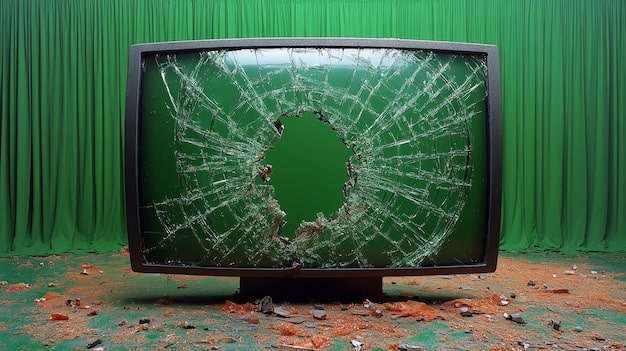Streaming Service Cancellations: Predicting 2025’s Chopping Block

Streaming service cancellations are an inevitable part of the industry, and predicting which shows might face the ax in 2025 involves analyzing viewership, production costs, renewal contracts, and overall strategic shifts by platforms like Netflix, Hulu, and Disney+ to optimize their content libraries.
The world of streaming is constantly evolving, and with that comes the harsh reality of **streaming service cancellations**. As we look ahead to 2025, many are wondering which shows will survive and which will face the chopping block. Let’s dive into what factors influence these decisions and which series might be at risk.
Understanding the Streaming Landscape in 2025
The streaming industry is fiercely competitive, with giants like Netflix, Amazon Prime Video, Disney+, and Hulu vying for dominance. Understanding the dynamics of this landscape is crucial to predicting which shows might be on the brink of cancellation. In 2025, several factors will continue to play significant roles in these decisions.
Key Metrics Driving Cancellations
One of the primary drivers behind show cancellations is viewership. Streaming services closely monitor how many people are watching a particular show and for how long. Engagement metrics, such as completion rates and repeat views, are equally important.
Content Strategy Shifts
Streaming platforms are constantly refining their content strategies to maximize subscriber retention and attract new users. This often involves a shift away from certain genres or types of shows that aren’t performing as well. Original programming is still king, but production costs are always in the back of the producers’ minds.
- High production costs are often unsustainable if viewership doesn’t justify the expense.
- Shows that fail to generate buzz or positive reviews are less likely to be renewed.
- Niche content may be sacrificed in favor of broader-appeal programming.
In conclusion, understanding the streaming landscape involves a careful assessment of viewership metrics, financial considerations, and strategic shifts by the major platforms. These factors collectively determine the fate of shows in an increasingly competitive market.

Potential Shows at Risk in 2025
With the dynamics of the streaming world in mind, several types of shows may be at risk of cancellation in 2025. Predicting specific titles is challenging, but we can identify patterns and characteristics that often lead to a show’s demise. Shows that have struggled to find an audience or have become too expensive to produce are often the first to go.
Struggling Performers: Low Viewership
Shows with consistently low viewership numbers are prime candidates for cancellation. These are often series that failed to capture audience interest or simply didn’t resonate with the platform’s subscriber base. Sometimes, it just doesn’t “click” and a streamer is left to decide whether to cut their losses.
High-Cost Productions with Diminishing Returns
Even shows with decent viewership can be at risk if their production costs are too high. Streaming services must balance the expense of creating content with the revenue it generates. If a show becomes excessively expensive without a corresponding increase in viewership, it may not be sustainable.
- Shows with elaborate special effects or high-profile talent often come with hefty price tags.
- Series that require extensive location shooting or complex post-production can quickly become budget-busters.
- As a show ages, the cost of talent can increase, making renewal less attractive.
In conclusion, many shows will continue to be on the chopping block, with streaming platforms carefully assessing their financials and viewership metrics. It is essential to assess the viewership, costs, and overall strategic alignment of the platform for any show deemed to be at risk.
The Impact of Content Licensing Agreements
Content licensing agreements play a crucial role in the availability of shows on streaming platforms. These agreements determine how long a service can host a particular show and under what terms. Changes or expirations of these agreements can significantly impact the lineup of available content. The agreements are often negotiated and complex.
Expiration and Renewal of Licenses
Many shows on streaming services are not original productions but are instead licensed from other studios or networks. These licenses have expiration dates, and renewing them can be a difficult or costly process. There are many points of negotiation, as well.
Shifting Priorities and Exclusive Content
As streaming services increasingly focus on original content, they may be less inclined to renew licenses for older shows. Instead, they may prioritize investing in exclusive content that they own outright. The market changes quickly and streamers have to adapt.

- The rise of platform-exclusive content makes licensed shows less valuable.
- Streaming services are increasingly consolidating their content libraries.
- The cost of renewing licenses can outweigh the perceived benefit.
In conclusion, content licensing agreements profoundly affect shows’ longevity on streaming services. As platforms shift priorities toward original content and exclusive offerings, licensed shows face an uncertain future. The negotiation and renewal of these agreements will continue to be a critical factor in determining which content stays and which goes.
How Viewer Engagement Influences Decisions
Viewer engagement is a critical metric that streaming services use to gauge the success and value of their shows. High viewership, completion rates, and positive social media buzz can all contribute to a show’s chances of renewal. Conversely, low engagement is often a death knell for a series. What makes a show “catch” can be a complicated formula.
Measuring Viewer Engagement
Streaming services employ sophisticated analytics tools to measure how viewers interact with their content. These metrics go beyond simple viewership numbers to include factors such as how long viewers watch, whether they complete episodes, and how often they return to a show.
Social Media and Word-of-Mouth
Social media plays a significant role in shaping viewer engagement. A show that generates buzz, positive reviews, and enthusiastic discussions is more likely to attract and retain viewers. Conversely, negative sentiment or a lack of social media traction can signal trouble.
- Positive word-of-mouth can drive organic viewership growth.
- Social media buzz can create a sense of community around a show.
- Streaming services often monitor social media trends to gauge audience sentiment.
In conclusion, viewer engagement is a vital determinant of a show’s fate on streaming services. Metrics such as viewership, completion rates, and social media buzz collectively influence decisions about which shows to renew or cancel. A show that captures and sustains viewer interest is far more likely to survive in the competitive streaming landscape.
The Role of Critical Acclaim and Awards
Critical acclaim and awards can significantly impact a show’s standing on streaming services. Positive reviews, nominations, and wins can boost a show’s profile, attract new viewers, and justify its continued production. The prestige associated with critical success can add value to a streaming platform’s brand.
The Influence of Reviews and Ratings
Critical reviews and ratings from reputable sources can influence potential viewers’ decisions about whether to watch a show. Positive reviews can create buzz and drive viewership, while negative reviews can deter potential fans.
Awards Season and Prestige
Award nominations and wins can elevate a show’s profile and attract new viewers. Awards recognition can also signal to streaming services that a show is worth investing in, even if its viewership numbers are not exceptionally high.
- Awards nominations and wins can boost a show’s prestige and marketability.
- Critical acclaim can attract a more discerning audience.
- Streaming services often leverage awards recognition in their marketing efforts.
In conclusion, it’s fair to say that critical acclaim and awards are important factors in determining the longevity of shows on streaming services. Positive reviews, nominations, and wins can enhance a show’s profile, attract viewers, and justify continued investment. The prestige associated with critical success can significantly contribute to a show’s survival in the competitive streaming landscape.
Financial Factors: Production Costs vs. Revenue
Financial factors are decisive in determining whether a show gets renewed or canceled. Streaming services must carefully weigh the production costs against the revenue generated by a show. High production costs, especially when coupled with low viewership, can quickly lead to cancellation. It’s just simple math, but with a splash of cultural relevance thrown in.
Balancing the Budget
Streaming services allocate significant resources to original content, but they must also manage their budgets effectively. Expensive productions require a strong return on investment, either through high viewership or other strategic benefits. The balance between initial budget and money brought in is a fine line to walk.
Strategic Considerations beyond Direct Revenue
In some cases, streaming services may choose to continue producing a show even if it’s not a direct revenue generator. A show might attract a specific demographic, enhance the platform’s reputation, or support other strategic goals. There could be benefits beyond direct financial gain.
- Shows that align with a platform’s brand identity may be prioritized.
- Programs can be used to attract and retain subscribers.
- Streaming services may use content as a marketing tool to promote their platform.
In conclusion, financial factors are essential in shaping decisions about streaming show renewals and cancellations. Streaming services must carefully assess the production costs, potential revenue, audience and strategic benefits of maintaining a show against the realities of the market.
| Key Point | Brief Description |
|---|---|
| 📉 Low Viewership | Shows with poor viewership are at high cancellation risk. |
| 💸 High Costs | Expensive productions may be cut if revenue doesn’t justify them. |
| 📜 Licensing Issues | Expired or costly licenses impact show availability. |
| 🏆 Lack of Awards | Shows without critical acclaim may be deemed less valuable. |
FAQ
▼
The main reasons include low viewership, high production costs, content licensing issues, and strategic shifts in the platform’s priorities. These factors help services optimize their content libraries.
▼
They use analytics tools to measure viewership, completion rates, and repeat views. Monitoring social media buzz and sentiment also plays a crucial role in gauging viewer engagement.
▼
Yes, positive reviews, awards nominations, and wins can boost a show’s profile and justify its continued production. It enhances the platform’s “cachet”.
▼
These agreements determine how long a service can host a show and under what terms. The expiration and renewal of licenses can significantly impact the availability of content.
▼
Viewers can engage with shows by watching episodes, completing series, and spreading positive buzz on social media. High engagement increases a show’s chances of renewal.
Conclusion
Predicting **streaming service cancellations** for 2025 requires a holistic view of viewership data, production costs, licensing agreements, and critical reception. As the streaming landscape continues to evolve, these factors will collectively determine which shows stay and which ones go, shaping the future of digital entertainment.





